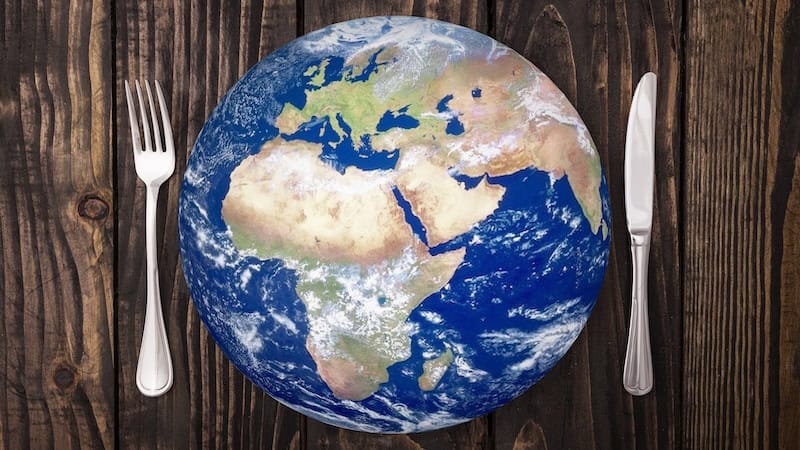Earth-Friendly Eating
For the good of the climate, your own health, and the future

What you eat affects not only your own health but the health of the planet. Here are some ways you can modify your habits for more Earth-friendly eating, from the experts at Environmental Nutrition.
The way the world eats has a significant impact on climate change, but so does the way we as individual consumers eat. Our dietary choices can be the most impactful thing we do, not only for our own health, but for that of the planet. Modern food production contributes to one-third of global greenhouse-gas emissions (GHGes), which are heating up the planet.
While changes to restructure the food system are necessary to limit global warming and climate change, we as individuals can make a difference starting with even small steps toward more sustainable food choices and dietary patterns. And while there is a growing awareness of our individual environmental footprint and its connection to sustainable food choices, many people struggle with how to make the most planet-friendly choices in the supermarket.
No need to worry — Environmental Nutrition has you covered with ways to navigate your path to Earth-friendly eating.
The need for sustainability
A sustainable food system is one in which food is produced using practices that protect the environment, but our modern food system, which has been in place for the last 50 years, competes with it.
“Our food system uses a significant amount of land, water, and fossil fuels to produce food, and also makes a large contribution to deforestation, pollution, and eutrophication, the excessive nutrient accumulation in bodies of water that can have negative impact,” according to Sharon Palmer, MSFS, RDN, SharonPalmer.com, co-founder of Food+Planet, a nonprofit organization with a mission to empower healthcare professionals to advance sustainable diets. This, Palmer explains, impacts climate change in a variety of ways, such as fossil fuel use, methane emissions, and taking natural ecosystems and converting them to agriculture, which releases carbon.
Climate change at Shenandoah National Park
Eating more plants
The Western diet is the result of our modern food system, with practices that negatively affect the environment but also human health with the production of foods that are highly processed, high in refined sugars and refined grains that have been associated with increased risk of diseases, such as diabetes and obesity.
“Research shows that eating a plant-based diet is one of the most impactful ways you can cut your environmental footprint,” says Palmer. In fact, research has found that 100% plant-based diets have about half the carbon footprint as omnivore diets, she says.
Research shows that the more plant-based a dietary pattern, the lower the environmental impact. A study published in Global Environmental Change (2020) compared healthy diet patterns of 140 countries and found vegan diets to have the highest environmental benefit, but the next best impacts were made by diets with lower meat consumption, such as two-thirds vegan, pescatarian, vegetarian, no dairy, reducing meat, and meatless once a week. Even shifting toward a Mediterranean eating style can significantly lower impact due to lower levels of meat.
Review of “The Complete Vegetarian Cookbook” from America’s Test Kitchen
Cutting food waste
Eating more whole plant foods is a key factor in keeping a low environmental footprint, but cutting food waste is another huge opportunity, Palmer says. “We waste at least 30% of our food today. Just think of the planetary impacts that it took to produce that food, all to go to the landfill,” she says. Of that 30%, consumers are responsible for upwards of two-thirds of it. The scraps, the leftovers gone bad, the expired or spoiled products — it all ends up in landfills, which release GHGes. Then there are all the resources that went into the growing and production of those foods from land, water, and energy, to the packaging and transport that brought them into our homes — wasted.
Taking on a global issue as individuals can feel like we’re too small to make a difference, but our food choices make a big impact, one bite at a time. You can significantly lower your environmental footprint by making simple tweaks to your diet (see Jumpstart Your Climate-Friendly Eating Journey).
Jumpstart Your Earth-Friendly Eating Journey
- Eat more plant foods, like whole grains and vegetables, which have small environmental footprints.
- Eat more plant proteins like beans and soy foods, which have one of the lowest environmental footprints, instead of animal foods — red meat in particular.
- If you eat meat, use it as a seasoning. Cut down on animal food intake while pushing plants by using meat as a flavoring in dishes instead of the main event.
- Convert your favorite dishes. Turn your favorite meat-based recipes veggie for an easy dinner solution.
- Lower your dairy consumption. Cows are ruminant animals, which contribute signifi- cantly to climate change through methane emissions, as well as land and water use.
- Reduce highly processed foods, which require more energy to transport ingredients, produce, package, and distribute.
- Reduce packaging of foods, which has its own carbon footprint.
- Eat more locally produced foods, which require no packaging and low transportation.
- Trim food waste — all of the food that is wasted has a significant environmental footprint.
Environmental Nutrition is the award-winning independent newsletter written by nutrition experts dedicated to providing readers up-to-date, accurate information about health and nutrition in clear, concise English. For more information, visit www.environmentalnutrition.com.


